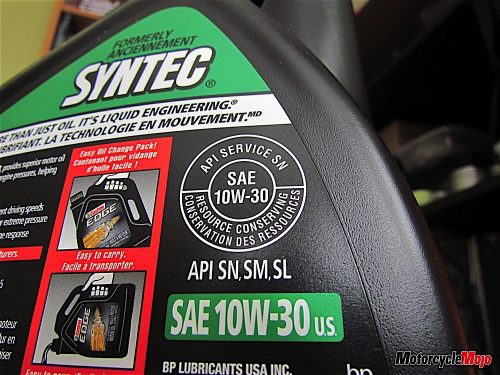A simple solution for delivering a smooth ride.
There’s a control system on your motorcycle that probably gets very little attention, yet it’s an important contributor to ride quality. It’s your bike’s cush-drive system, and its job is to smooth driveline lash when getting on and off the gas, and to soften the power pulses transmitted to the rear wheel from the crankshaft.
When a piston pushes down on the connecting rod during the power stroke, it does so with a violent shock. The flywheel’s mass smoothes some of this shock, but if the remainder of the force generated by these power pulses goes unchecked, it can make your ride uncomfortable, as well as damage driveline components.
 Cush drives use either rubber dampers or spring-loaded mechanisms to soften driveline shock. The most common type is the rubber cush drive, and it’s located within the enlarged portion of the rear wheel hub, behind the sprocket. In a motorcycle with a cush drive, the rear sprocket is bolted to a removable carrier, which interlocks with rubber dampers inserted into the wheel. Power is transferred to the wheel through the rubber dampers, and it’s the dampers’ pliancy that absorbs the power-pulse shocks.
Cush drives use either rubber dampers or spring-loaded mechanisms to soften driveline shock. The most common type is the rubber cush drive, and it’s located within the enlarged portion of the rear wheel hub, behind the sprocket. In a motorcycle with a cush drive, the rear sprocket is bolted to a removable carrier, which interlocks with rubber dampers inserted into the wheel. Power is transferred to the wheel through the rubber dampers, and it’s the dampers’ pliancy that absorbs the power-pulse shocks.
This is why, if you have an older bike, you should inspect the dampers any time the rear wheel is removed. These dampers harden with age and can eventually even crumble to pieces. They also compress with age, introducing a lot of free play between the sprocket and wheel, and subsequently a lot of driveline lash. This is very easy to diagnose without removing the wheel: just hold the rear brake and, with the engine running and the bike in gear, slowly release the clutch. If the rear sprocket rotates freely for several degrees before stopping, the rubber dampers are worn out.
 You can extend the service life of the rubber cush drive by using silicone spray to lubricate the rubber dampers when assembling the sprocket carrier. However, don’t use any type of grease, as it might swell the rubber, but more importantly, it will collect dirt, which will cause damage to the hub and rubbers.
You can extend the service life of the rubber cush drive by using silicone spray to lubricate the rubber dampers when assembling the sprocket carrier. However, don’t use any type of grease, as it might swell the rubber, but more importantly, it will collect dirt, which will cause damage to the hub and rubbers.
A close look at Harley Big Twins and Sportsters reveals that there’s no cush drive in the rear wheel. Harley instead uses a mechanical shock damper called a compensating sprocket, which is mounted on the end of the crankshaft, within the primary case. Because a Harley engine is a big V-twin with a long stroke, the power pulses are rather forceful; placing the damper on the crankshaft reduces the shock loads on the entire driveline, including the clutch and transmission.
A compensating sprocket comprises a pair of spring-loaded tri-peaked cams (newer bikes use an improved variation of this system) mounted on the crank’s output shaft: one is incorporated into the primary drive sprocket and is free to rotate on the shaft; the other is splined to the shaft and can slide in and out on it. It’s the overlapping cam lobes that transfers engine power from the engine to the primary chain. When there’s no torque being applied to the compensating sprocket, the spring tension pushes the cams together, but when torque is being applied, the sliding cam rides up the ramp on the adjoining cam, compressing the spring and absorbing the shock. When torque relaxes, the spring pushes the moveable cam back in. It does this repeatedly with each power stroke.
Most Harleys use oil in the primary case, and it lubricates the compensating sprocket. However, high mileage will wear the compensating sprocket cams, and age will fatigue the spring. Both of these conditions will introduce excessive play in the unit, and it can get very noisy, sounding very much like a bad connecting-rod bearing at idle. If it gets excessively worn, the cams can actually jump lobes, causing a very loud clunking noise on acceleration. The fix is to replace the worn components.
Some older Harleys have a dry belt primary drive, and these bikes use a rubber-damped front belt sprocket. Engine heat and high loads shorten the lifespan of the rubber considerably on these bikes, though the rubbers are relatively easy to replace.
Despite its importance, not all motorcycles have cush drives. Dedicated off-road bikes, like motocrossers and enduros (not street-legal dual sports), do not have a cush drive. Manufacturers deliberately leave it out on these bikes to reduce weight. However, engineers still account for some form of shock-absorbing capability, and it comes from an unlikely source: because these bikes are designed to be ridden primarily off-road, it’s the lack of traction on dirt that damps the engine’s power pulses.
If you convert one of these bikes for road use, just bear in mind that you’ll probably experience premature chain and sprocket wear, and even see wear on the transmission output shaft, so inspect everything often.












